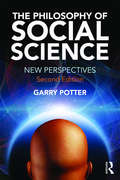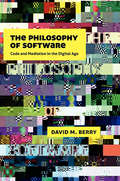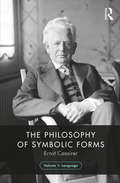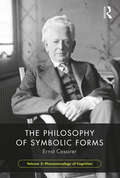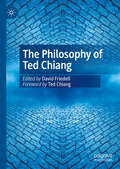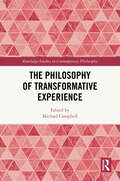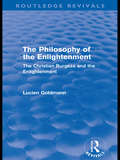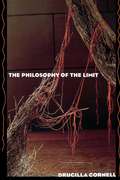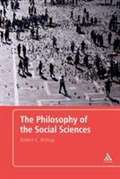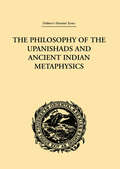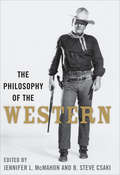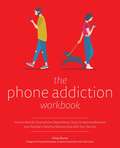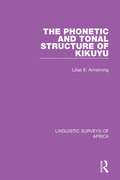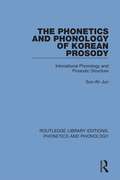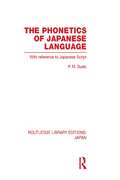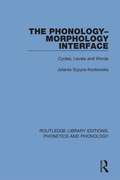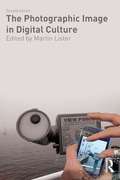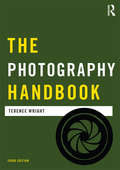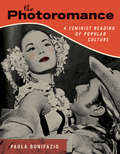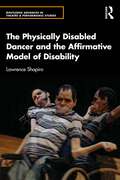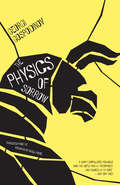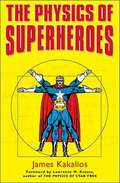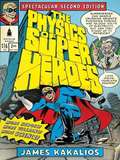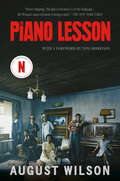- Table View
- List View
The Philosophy of Social Science: An introduction
by Martin HollisThis textbook by Martin Hollis offers an exceptionally clear and concise introduction to the philosophy of social science. It examines questions which give rise to fundamental philosophical issues. Are social structures better conceived of as systems of laws and forces, or as webs of meanings and practices? Is social action better viewed as rational behaviour, or as self-expression? By exploring such questions, the reader is led to reflect upon the nature of scientific method in social science. Is the aim to explain the social world after a manner worked out for the natural world, or to understand the social world from within?
The Philosophy of Social Science: New Perspectives, 2nd edition
by Garry PotterNow in its second edition, this comprehensive textbook offers an exceptionally accessible yet in-depth introduction to the philosophy of social science. Students with no previous knowledge will find themselves taken on an engaging philosophical journey: the book’s unique dialogue format anticipates their most frequently asked questions and provides clear explanations of specialised terminology and essential contextualisation of contemporary debates. Encompassing both traditional and contemporary perspectives, the book explores the questions and debates raised by all the major theoretical positions in the philosophy of social science, including positivism, empiricism, rationalism, hermeneutics, feminist epistemology, postmodernism and critical realism. The first edition of this book had a Eurocentric bias, as does virtually all other textbooks covering this subject matter. This has been corrected in the second edition and includes a new chapter on the contributions of Islam to philosophy, natural science social science including sociology. The second edition also has a newly written chapter on pragmaticism and neo-pragmaticism, as well as strengthened coverage of hermeneutics, postmodernism and critical realism. The book‘s rich pedagogic support includes: point-by-point summaries introducing the scope of every chapter; discussion questions; further reading lists; and a glossary of key terminology. This excellent textbook is designed to provide every student with a clear understanding of important and complex issues. It is essential reading for all students of philosophy of social science, whether at undergraduate or Masters level and regardless of their disciplinary background. ?
The Philosophy of Software: Code and Mediation in the Digital Age
by D. BerryThis book is a critical introduction to code and software that develops an understanding of its social and philosophical implications in the digital age. Written specifically for people interested in the subject from a non-technical background, the book provides a lively and interesting analysis of these new media forms.
The Philosophy of Symbolic Forms, Volume 1: Language (The Philosophy of Symbolic Forms)
by Ernst Cassirer"The Philosophy of Symbolic Forms is a milestone in twentieth century philosophy. Promoting a philosophical vision informed by Kant, it incorporates the philosophical advances achieved in the nineteenth century by German Idealism and Neo-Kantianism, whilst acknowledging the contributions made by his contemporary phenomenologists. It also encompasses empirical and historical research on culture and the most contemporary work on myth, linguistics and psychopathology. As such, it ranks in philosophical importance along with other major works of the twentieth century, such as Edmund Husserl’s Logical Investigations, Martin Heidegger’s Being and Time, and Ludwig Wittgenstein’s Tractatus Logico-Philosophicus.In the first volume, Cassirer explores the symbolic form of language. Already recognized by thinkers in the tradition of German Idealism, such as Wilhelm von Humboldt, language is the primary medium by which we interact with others and form a common world. As Cassirer emphasizes in the famous Davos Debate with Heidegger, 'there is one objective human world, in which a bridge is built from individual to individual. That I find in the primal phenomenon of language.' The famous trias Cassirer discerns in the functioning of language – the functions of expression (Ausdruck), presentation (Darstellung), and signification (Bedeutung) – has become paradigmatic for accounts of language, philosophical, linguistic, and anthropological alike."Sebastian Luft, Professor of Philosophy, Marquette University, USA.This new translation makes Cassirer’s seminal work available to a new generation of scholars. Each volume includes a translator’s introduction by Steve G. Lofts, a foreword by Peter E. Gordon, a glossary of key terms, and an index.
The Philosophy of Symbolic Forms, Volume 3: Phenomenology of Cognition (The Philosophy of Symbolic Forms)
by Ernst Cassirer“In his Phenomenology of Cognition, Cassirer provides a comprehensive and systematic account of the dynamic process involved in the whole of human culture as it progresses from the world of myth and its feeling of social belonging to the highest abstractions of mathematics, logic and theoretical physics. Cassirer engages with the most sophisticated and cutting-edge work in fields ranging from ethnology to classics, egyptology and assyriology to ethology, brain science and psychology to logic, mathematics and theoretical physics. His command of philosophy, literature, and the arts is superb.Echoing his work on Kant, Cassirer begins The Philosophy of Symbolic Forms with the problem posed by the meaning of being for philosophy since Plato. But Cassirer also shows that this problem gains new significance with Kant and with the development of modern culture. Cassirer weaves his conception of the development of knowledge into a broadly Kantian and German idealist dynamic-historical conception of significance and of experience that refuses to accept a fundamental opposition between literary, philosophical and scientific culture. In consequence of his great vision grounded in careful reflection and argument, Cassirer’s systematic conception of the Copernican cosmopolitan-cosmological revolution is still philosophically and scientifically unmatched in contemporary philosophy on both sides of the Atlantic and of the Pacific.”Pierre Keller, Professor of Philosophy, University of California, Riverside, USA.This new translation makes Cassirer’s seminal work available to a new generation of scholars. Each volume includes a translator’s introduction by Steve G. Lofts, a foreword by Peter E. Gordon, a glossary of key terms, and an index.
The Philosophy of Ted Chiang
by David FriedellTed Chiang is one of the most insightful science fiction writers of our time. His writing has garnered high praise, including four Nebula awards, four Hugo awards and the John W. Campbell Award for Best New Writer. His short story, “Story of Your Life,” was the basis of the 2016 film Arrival. This volume, which includes a foreword by Chiang and twenty-one short essays by philosophers, analyzes the philosophical significance of Chiang’s popular science fiction. These essays discuss how Chiang’s stories engage with age-old and contemporary philosophical questions pertaining to free will, God, technology, existentialism, beauty, procreation, contradictions, time, human intelligence, alien intelligence, and artificial intelligence. This volume probes terrain that should be of interest to experts in philosophy, while still being accessible to a general audience interested in science fiction. These essays, like Ted Chiang’s writing, demonstrate how excellent science fiction can help us to think about the world and our place in it.
The Philosophy of Transformative Experience (Routledge Studies in Contemporary Philosophy)
by Michael CampbellThis volume examines the nature and significance of transformative experiences as they occur across a variety of contexts in human life. By treating these events as social as well as individual phenomena, the essays bring to light the various ways in which cultural and institutional forces influence narratives of personal change. The ease with which we identify transformative experiences shows their importance for our sense of the potentialities inherent in human life, even while their disruptive character threatens confidence in our capability to make rational decisions concerning our future well-being. Yet, narratives of transformation are not just individual artefacts, but are also given support and structure through social forces including shared languages, practices, and institutions. What are the cultural and institutional contexts which enable this form of self-conceptualisation, and what happens when social changes undermine the cogency of these narratives? The chapters in this volume investigate these issues through a blend of philosophical theory and applied cases, working across the disciplinary boundaries of philosophy and social anthropology. Contributors investigate topics including recovery from trauma; the role of narratives in gender transition; climate activism; the ethical ramifications of war; the role of media in framing narratives of ethical change; and the university as a site of transformative experience. The Philosophy of Transformative Experience will be of interest to philosophers working in ethics, political philosophy, and decision theory, as well as scholars and advanced students in anthropology, sociology, and literary studies.
The Philosophy of the Enlightenment: The Christian Burgess and the Enlightenment (Routledge Revivals)
by Lucien GoldmannIn this reissue, originally published in English in 1973, French philosopher Lucien Goldmann turns his attention to the Enlightenment of the eighteenth century, the great age of liberalism and individualism and analyses the ‘mental structures’ of the outlook of the philosophes, who showed that the ancien regime and the privileges of the Church were irrational anachronisms. In assessing the strengths and limitations of individualism, Goldmann considers the achievements and limitations of the Enlightenment. He discusses the views of Hegel and Marx and examines the relation between liberal scepticism and traditional Christianity to point the way to the possible reconciliation of the two seemingly incompatible ‘world visions’ of East and West today.
The Philosophy of the Limit
by Drucilla CornellIn The Philosophy of the Limit Drucilla Cornell examines the relationship of deconstruction to questions of ethics, justice and legal interpretation. She argues that renaming deconstruction "the philosophy of the limit" will allow us to be more precise about what deconstruction actually is philosophically and hence to articulate more clearly its significance for law. Cornell's focus on the importance of the limit and the centrality of the gender hierarchy allows her to offer a view of jurisprudence different from both the critical social theory and analytic jurisprudence.
The Philosophy of the Social Sciences: An Introduction
by Robert BishopThe book not only offers lucid and incisive coverage of the philosophy of the social sciences, but also extends the major debates and considers the latest directions in this growing area of philosophical interest. Robert C. Bishop's cogent and rigorous analysis is supplemented by useful pedagogical features, including key examples from philosophical writing; summaries of core debates; sample questions and exercises; and guides for further reading.
The Philosophy of the Upanishads and Ancient Indian Metaphysics: As Exhibited In A Series Of Articles Contributed To The Calcutta Review (classic Reprint)
by Archibald Edward GoughFirst Published in 2000. Routledge is an imprint of Taylor & Francis, an informa company.
The Philosophy of the Western (The Philosophy of Popular Culture #Ppcs)
by Jennifer L. McMahon and B. Steve CsakiEssays about how stories of the Old West reflect—and affect—our beliefs and values.The solitude of the lone rider, the loyalty of his horse, and the unspoken code of the West—for many, Western movies embody America and its values, though the view of the country&’s history they present isn&’t always accurate. In recent years, scholars had declared the genre dead, but a steady resurgence of western themes in literature, film, and television has reestablished its importance and influence.In The Philosophy of the Western, editors Jennifer L. McMahon and B. Steve Csaki examine philosophical themes in the western genre. Investigating subjects of nature, ethics, identity, gender, environmentalism, and animal rights, the essays in this volume draw from a wide range of westerns including the more recent popular and critical successes Unforgiven, All the Pretty Horses, 3:10 to Yuma, and No Country for Old Men, as well as literature and television serials such as Deadwood. The Philosophy of the Western reveals the powerful role of the western in the American psyche.
The Phone Addiction Workbook: How to Identify Smartphone Dependency, Stop Compulsive Behavior and Develop a Healthy Relationship with Your Devices
by Hilda BurkeStop scrolling and start living! Build healthier relationships between you, your smartphone and all your devices, including tips to reduce social media obsession, notification anxiety and other unhealthy habits.Your smartphone is a powerful device that has fundamentally changed your life—no doubt improving it in many ways. And while you don’t need to give up your smartphone completely, if your day to day is filled with endless, anxiety-inducing checking, swiping and liking, then you need this helpful, step-by-step workbook to take back control of your life.Phone addiction is similar to gambling addiction and substance abuse. Its consequences include stress, depression, insomnia, intimacy issues and more. Written by an experienced psychotherapist, couples therapist and former telecommunications industry insider, The Phone Addiction Workbook’s program offers the blueprint for understanding addictive behavior and how it controls you. Weekly charts, practical tips and interactive activities help you stop unhealthy behavior and make lasting change.
The Phonetic and Tonal Structure of Kikuyu (Linguistic Surveys of Africa #21)
by Lilias A. ArmstrongOriginally published in 1940, this book was the result of 3 years' worth of phonetic research and analysis with the aim of laying foudnations for improved methods of teaching and ascertaining the most scientific basis for current orthography of the Kikuyu language of Kenya.
The Phonetics and Phonology of Korean Prosody: Intonational Phonology and Prosodic Structure (Routledge Library Editions: Phonetics and Phonology #12)
by Sun-Ah JunFirst published in 1996. This book examines the phonetics and phonology of Korean prosody. Based on phonetic experiments, it proposes intonationally marked prosodic constituents above the word which condition various connected speech phenomena. This title will be of interest to students of language and linguistics.
The Phonetics of Japanese Language: With Reference to Japanese Script (Routledge Library Editions: Japan)
by P M SuskiThis book gives true characters of Japanese speech sounds in reference to European speech sounds. When it was first published in 1931, it was the first book of its kind. There are only 5 Japanese vowel elements as opposed to 18 in English, 13 in French and 8 in German. There are 15 Japanese consonants, 26 in English, 22 in French & 23 in German. Because of the lesser number of elements, it follows that the wider range in vowels and consonants is heard by Japanese ears, so this volume gives average sounds uttered by Japanese in the twentieth century in relation to the English sounds.
The Phonology-Morphology Interface: Cycles, Levels and Words (Routledge Library Editions: Phonetics and Phonology #22)
by Jolanta Szpyra-KozłowskaFirst published in 1989. The development of morphological and phonological theory within the broad framework of generative grammar poses a number of important questions concerning the mutual relationship of phonology and morphology. This study aims to answer these questions. On the basis of Polish and English language material, the author examines the most important aspects of phonology-morphology interaction, and suggests the best model with which to describe these phenomena.
The Photographic Image in Digital Culture (Comedia)
by Martin ListerThis new edition of The Photographic Image in Digital Culture explores the condition of photography after some 20 years of remediation and transformation by digital technology. Through ten especially commissioned essays, by some of the leading scholars in the field of contemporary photography studies, a range of key topics are discussed including: the meaning of software in the production of photograph; the nature of networked photographs; the screen as the site of photographic display; the simulation of photography in the videogame; photography, ubiquitous computing and technologies of ambient intelligence; developments in vernacular photography and social media; the photograph and the digital archive; the curation and exhibition of the networked photograph; the dominance of the image bank in commercial and advertising photography; the complexities of citizen photojournalism. A recurring theme addressed throughout is the nature of ‘photography after photography’ and the paradoxical nature of the medium in the 21st century; a time when the traditional technology of photography has become defunct while there is more ‘photography’ than ever. This is an ideal book for students studying photography and digital media.
The Photography Handbook (Media Practice)
by Terence WrightThe new edition of The Photography Handbook builds on previous editions’ illuminating overview of the history, theory and practice of the creation and consumption of photographic images, and engages with the practical and theoretical implications of the explosion of new platforms for making, viewing and distributing images. New materials in this edition includes new chapters on ‘Photo-elicitation’ and ‘Photography and Technological Change’, exploration and analysis of ‘selfie’ culture, and extensive discussion of the work and practices by a new generation photographic artists. The Photography Handbook, Third edition also features: exploration and discussion of key photographic terms, including composition, framing, visualisation, formalism and realism analysis of the ethics of photojournalism, and ethical issues specific to digital photography practice today case studies illustrating different photographic production practices and specific related issues, including an assignment for the Guardian, the Libyan People’s Bureau siege, and the work of war photographers a foregrounding of digital photographic practices, and exploration of areas including photographic manipulation, digital photojournalism, citizen journalists and copyright on the internet end of chapter summaries of key points, and an extensive glossary of essential photography terms. The Photography Handbook, Third edition is an invaluable resource for students, scholars and practitioners of photography, and all those seeking to understand its place in today’s society.
The Photoromance: A Feminist Reading of Popular Culture
by Paola BonifazioA fascinating feminist reading of an often scorned medium: the storytelling, cross-platform success, and female fandom of the photoromance.Born in Italy and successfully exported to the rest of the world, photoromances had a readership of millions in the postwar years. By the early 1960s, more than ten million Italians read a photoromance each week. Despite its popularity, the photoromance--a form of graphic storytelling that uses photographs instead of drawings--was widely scorned as a medium, and its largely female audience derided as naive, pathetic, and uneducated. In this provocative book, Paola Bonifazio offers another perspective, making a case for the relevance of the photoromance for both feminism and media culture. She argues that the photoromance pioneered storytelling across platforms, elevated characters and artists into brands, and nurtured a devoted fan base. Moreover, Bonifazio shows that female readers--condescended to by intellectuals, journalists, and politicians of both the left and the right--powered the Italian photoromance industry's success.
The Physically Disabled Dancer and the Affirmative Model of Disability (Routledge Advances in Theatre & Performance Studies)
by Lawrence ShapiroThis volume investigates the contributions and achievements of the physically disabled dancer while challenging and recognizing the inherent inequities in the field of integrated dance in the UK which currently places greater emphasis on the learning‑disabled performer. This is the first book ever written by a physically disabled dancer on the subject of physically disabled dancers. Inherent in this examination is the model of examining disability that is most closely associated with the disability arts movement which is the ‘affirmative model of disability’. This model is defined as an approach to disability in which the disabled person is neither an object of medical care nor a victim of social indifference but a self‑respecting, autonomous individual in which their disability is a positive and affirming aspect of their self‑identity. This book, based on interviews with physically disabled dancers, choreographers, academics and arts producers all in a UK context, combines a wide range of perspective of disability dance together with the intellectual rigour of disability studies to produce a new definition of the physically disabled dancer as an affirming, positive, indispensable practitioner of contemporary performance art. The volume pioneers perspectives of the physically disabled dancer prioritizing first‑person accounts from the performers themselves to produce an unprecedented contribution to the study of disability arts from a uniquely British perspective.This book will offer educators as well as arts and cultural professionals a critical resource for facilitating work by and in alliance with practitioners of integrated dance.
The Physics of Sorrow
by Angela Rodel Georgi Gospodinov"Georgi Gospodinov wants to blow your mind--or maybe just provide the ultimate bathroom reader. . . . The formal playfulness suggests Kundera with A.D.D. and potty jokes."--Ed Park, The Village VoiceA finalist for both the Strega Europeo and Gregor von Rezzori awards (and winner of every Bulgarian honor possible), The Physics of Sorrow reaffirms Georgi Gospodinov's place as one of Europe's most inventive and daring writers.Using the myth of the Minotaur as its organizing image, the narrator of Gospodinov's long-awaited novel constructs a labyrinth of stories about his family, jumping from era to era and viewpoint to viewpoint, exploring the mindset and trappings of Eastern Europeans. Incredibly moving--such as with the story of his grandfather accidentally being left behind at a mill--and extraordinarily funny--see the section on the awfulness of the question "how are you?"--Physics is a book that you can inhabit, tracing connections, following the narrator down various "side passages," getting pleasantly lost in the various stories and empathizing with the sorrowful, misunderstood Minotaur at the center of it all.The Physics of Sorrow will appeal to fans of Dave Eggers, Tom McCarthy, and Dubravka Ugresic for its unique structure, humanitarian concerns, and stunning storytelling.Georgi Gospodinov's Natural Novel was published by Dalkey Archive Press in 2005 and was praised by the New Yorker, New York Times, and several other prestigious review outlets.Angela Rodel won a PEN Translation Fund Grant in 2010 for Georgi Tenev's short story collection. She is one of the most prolific translators of Bulgarian literature working today and received an NEA Fellowship for her translation of Gospodinov's The Physics of Sorrow.
The Physics of Superheroes
by James KakaliosA complete update to the hit book on the real physics at work in comic books, featuring more heroes, more villains, and more science Since 2001, James Kakalios has taught "Everything I Needed to Know About Physics I Learned from Reading Comic Books," a hugely popular university course that generated coast-to-coast media attention for its unique method of explaining complex physics concepts through comics. With The Physics of Superheroes, named one of the best science books of 2005 by Discover, he introduced his colorful approach to an even wider audience. Now Kakalios presents a totally updated, expanded edition that features even more superheroes and findings from the cutting edge of science. With three new chapters and completely revised throughout with a splashy, redesigned package, the book that explains why Spider-Man's webbing failed his girlfriend, the probable cause of Krypton's explosion, and the Newtonian physics at work in Gotham City is electrifying from cover to cover. .
The Physics of Superheroes: Spectacular Second Edition
by James KakaliosA complete update to the hit book on the real physics at work in comic books, featuring more heroes, more villains, and more science Since 2001, James Kakalios has taught "Everything I Needed to Know About Physics I Learned from Reading Comic Books," a hugely popular university course that generated coast-to-coast media attention for its unique method of explaining complex physics concepts through comics. With The Physics of Superheroes, named one of the best science books of 2005 by Discover, he introduced his colorful approach to an even wider audience. Now Kakalios presents a totally updated, expanded edition that features even more superheroes and findings from the cutting edge of science. With three new chapters and completely revised throughout with a splashy, redesigned package, the book that explains why Spider-Man's webbing failed his girlfriend, the probable cause of Krypton's explosion, and the Newtonian physics at work in Gotham City is electrifying from cover to cover.
The Piano Lesson (Drama, Plume Ser.)
by August WilsonWinner of the Pulitzer Prize for Drama and winner of the New York Drama Critics Circle Award for Best Play, this modern American classic is about family, and the legacy of slavery in America. August Wilson has already given the American theater such spell-binding plays about the black experience in 20th-century America as Ma Rainey's Black Bottom, Joe Turner's Come and Gone, and the Pulitzer Prize-winning Fences. In his second Pulitzer Prize-winner, The Piano Lesson, Wilson has fashioned perhaps his most haunting and dramatic work. At the heart of the play stands the ornately carved upright piano which, as the Charles family's prized, hard-won possession, has been gathering dust in the parlor of Berniece Charles's Pittsburgh home. When Boy Willie, Berniece's exuberant brother, bursts into her life with his dream of buying the same Mississippi land that his family had worked as slaves, he plans to sell their antique piano for the hard cash he needs to stake his future. But Berniece refuses to sell, clinging to the piano as a reminder of the history that is their family legacy. This dilemma is the real "piano lesson," reminding us that blacks are often deprived both of the symbols of their past and of opportunity in the present.

